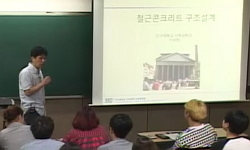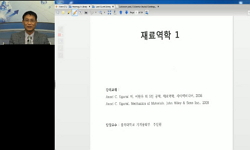This paper introduces the construction of Strut-Tie model based on the Evolutionary Structural Optimization(ESO) method. Differently from conventional ESO method which uses plane stress elements, the introduced approach adopts the use of truss element...
http://chineseinput.net/에서 pinyin(병음)방식으로 중국어를 변환할 수 있습니다.
변환된 중국어를 복사하여 사용하시면 됩니다.
- 中文 을 입력하시려면 zhongwen을 입력하시고 space를누르시면됩니다.
- 北京 을 입력하시려면 beijing을 입력하시고 space를 누르시면 됩니다.

점진적 구조 최적화 기법을 이용한 철근 콘크리트 구조물의 전단 해석 = Shear Analysis of RC Structure using Evolutionary Structural Optimization
한글로보기https://www.riss.kr/link?id=A101121782
-
저자
곽효경 (한국과학기술원) ; 양규영 (KAIST) ; 신동규 (한국과학기술원) ; Kwak, Hyo-Gyoung ; Yang, Kyu-Young ; Shin, Dong-Kyu
- 발행기관
- 학술지명
- 권호사항
-
발행연도
2011
-
작성언어
Korean
- 주제어
-
등재정보
KCI등재
-
자료형태
학술저널
- 발행기관 URL
-
수록면
319-328(10쪽)
-
KCI 피인용횟수
1
- 제공처
- 소장기관
-
0
상세조회 -
0
다운로드
부가정보
다국어 초록 (Multilingual Abstract)
This paper introduces the construction of Strut-Tie model based on the Evolutionary Structural Optimization(ESO) method. Differently from conventional ESO method which uses plane stress elements, the introduced approach adopts the use of truss elements with the fact that the optimum topology of structures by ESO method is open a truss-like structure. Several examples are provided to demonstrate the capability of the proposed method in finding the best Strut-Tie models. In advance, it is shown that the introduced method is supported through the correlation studies between two-dimensional plane stress analysis and Strut-Tie models, and can be used effectively in practice, especially in shear design of complex reinforced concrete members where no previous experience is available.
국문 초록 (Abstract)
이 논문은 ESO 기법을 기초로 한 Strut-Tie 모델의 구성을 제안하고 있다. 평면응력 요소를 사용한 기존의 ESO방법과 달리, ESO기법에 의해 최적화된 구조가 트러스와 비슷한 형태를 가지는 사실...
이 논문은 ESO 기법을 기초로 한 Strut-Tie 모델의 구성을 제안하고 있다. 평면응력 요소를 사용한 기존의 ESO방법과 달리, ESO기법에 의해 최적화된 구조가 트러스와 비슷한 형태를 가지는 사실에 기인하여, Strut-Tie 모델을 통한 전단설계에 트러스 요소를 사용한 ESO기법을 새롭게 적용하였다. 예제들을 통해 제안된 방법이 가장 좋은 Strut-Tie 모델을 찾을 수 있음을 입증하였으며, 앞서 2차원 평면응력 요소와 Strut-Tie 모델의 연관성에 대한 연구를 통해 ESO방법이 효과적으로 사용될 수 있음은 물론 경험하지 못한 특히 복잡한 철근 콘크리트 구조물의 전단설계에 효과적으로 사용이 가능한 대안이 될 수 있을 것으로 판단된다.
참고문헌 (Reference)
1 김우, "콘크리트구조설계" McGraw-Hill Education 2005
2 곽계환, "철근콘크리트 구조설계 제 1판 5쇄" 청문각 2009
3 최창근, "유한요소법" 테크노프레스 2002
4 Schlaich, J, "Toward a Consistent Design of Structural Concrete" 32 (32): 74-147, 1987
5 Liang, Q.Q, "Topology Optimization of Strut-and-Tie Models in Reinforced Concrete Structures using an Evolutionary Procedure" 97 (97): 322-330, 2000
6 Hong, S.G, "Strut-and-Tie Models and Failure Mechanisms for Bar Development in Tension- Tension- Compression Nodal Zone" 97 (97): 111-121, 2000
7 임승욱, "Strut-Tie model을 이용한 철근 콘크리트 부재의 전단 설계" 명지대학교 7 : 119-141, 1992
8 Qing, Li, "Shape and Topology Design for Heat Conduction by Evolutionary Structural Optimization" 42 : 3361-3371, 1999
9 Computers and Structures, Inc, "SAP2000 Analysis Reference"
10 ASCE-ACI Committee 445, "Recent Approaches to Shear Design of Structural Cncrete" 124 (124): 1375-1471, 1998
1 김우, "콘크리트구조설계" McGraw-Hill Education 2005
2 곽계환, "철근콘크리트 구조설계 제 1판 5쇄" 청문각 2009
3 최창근, "유한요소법" 테크노프레스 2002
4 Schlaich, J, "Toward a Consistent Design of Structural Concrete" 32 (32): 74-147, 1987
5 Liang, Q.Q, "Topology Optimization of Strut-and-Tie Models in Reinforced Concrete Structures using an Evolutionary Procedure" 97 (97): 322-330, 2000
6 Hong, S.G, "Strut-and-Tie Models and Failure Mechanisms for Bar Development in Tension- Tension- Compression Nodal Zone" 97 (97): 111-121, 2000
7 임승욱, "Strut-Tie model을 이용한 철근 콘크리트 부재의 전단 설계" 명지대학교 7 : 119-141, 1992
8 Qing, Li, "Shape and Topology Design for Heat Conduction by Evolutionary Structural Optimization" 42 : 3361-3371, 1999
9 Computers and Structures, Inc, "SAP2000 Analysis Reference"
10 ASCE-ACI Committee 445, "Recent Approaches to Shear Design of Structural Cncrete" 124 (124): 1375-1471, 1998
11 Chu, D.Nha, "On Various Aspects of Evolutionary Structural Optimization for Problems with Stiffness Constraints" 24 : 197-212, 1997
12 Yun, Y.M, "Nonlinear Strut-Tie model Approach for Structural concrete" 97 (97): 581-590, 2000
13 Yun, Y.M, "Nonlinear Strut-Tie Model Approach in Structural Concrete Deep Beams" 193 : 689-706, 2000
14 Bendsoe, M.P, "Generating Optimal Topologies in Structural Design using a Homogenization Methods" 71 : 197-224, 1988
15 Liang, Q.Q, "Generating Optimal Strut-and-Tie Models in Prestressed Concrete Beams by Performance-Based Optimization" 98 (98): 226-232, 2001
16 ASCE-ACI Structural Journal, "Examples for the Design of Structural Concrete with Strut-and- Tie models(SP-208)"
17 Qing, Li, "Evolutionary Structural Optimization for Stress Minimization Problems by Discrete Thickness Design" 78 : 769-780, 2000
18 Xie, Y.M, "Evolutionary Structural Optimization for Dynamic Problems" 58 : 1067-1073, 1996
19 Xie, Y.M, "Evolutionary Structural Optimization" Springer 1997
20 Chen, B.S, "Evaluation of Strut-and-Tie Model Applied to Deep Beam with Opening" 99 (99): 445-450, 2002
21 McGregor, J.G, "Dimentioning and Detailing" 391-, 1991
22 Ritter, W, "Die Bauweise Hennebique(The Hennebique System), Schweizerische Bauzeitung, Bd. ΧΧΧΙΙΙ" 7-, 1899
23 MOrsch, E, "Der Eisenbetonbau, Seine Theorie und Anwendung(Reinforced Concrete, Theory and Application)" Verlag Konrad Wittwer 1912
24 Yun, Y.M, "Computer Graphics for Nonlinear Strut-Tie Model Approach" 14 (14): 127-133, 2000
25 Xie, Y.M, "An Improved Method for Evolutionary Structural Optimization Against Buckling" 79 : 253-263, 2001
26 Xie, Y.M, "A Simple Evolutionary Procedure for Structural Optimization" 19 : 885-896, 1997
동일학술지(권/호) 다른 논문
-
인장연화거동을 고려한 강섬유 보강 초고성능 콘크리트 보의 모멘트-곡률 해석
- 한국전산구조공학회
- 양인환
- 2011
- KCI등재
-
적층평판의 응력해석 향상을 위한 고전적 고차전단변형이론의 개선
- 한국전산구조공학회
- 김준식
- 2011
- KCI등재
-
건물의 상시진동계측과 인력가진계측을 통한 동적특성 비교
- 한국전산구조공학회
- 장영주
- 2011
- KCI등재
-
지부재에 축하중을 받는 K형 관이음부의 내부 환보강재의 설치 및 배치효과 평가
- 한국전산구조공학회
- 조현만
- 2011
- KCI등재
분석정보
인용정보 인용지수 설명보기
학술지 이력
| 연월일 | 이력구분 | 이력상세 | 등재구분 |
|---|---|---|---|
| 2028 | 평가예정 | 재인증평가 신청대상 (재인증) | |
| 2022-01-01 | 평가 | 등재학술지 유지 (재인증) |  |
| 2019-01-01 | 평가 | 등재학술지 유지 (계속평가) |  |
| 2016-01-01 | 평가 | 등재학술지 선정 (계속평가) |  |
| 2015-12-01 | 평가 | 등재후보로 하락 (기타) |  |
| 2011-01-01 | 평가 | 등재학술지 유지 (등재유지) |  |
| 2009-01-01 | 평가 | 등재학술지 유지 (등재유지) |  |
| 2007-01-01 | 평가 | 등재학술지 유지 (등재유지) |  |
| 2005-05-29 | 학술지명변경 | 외국어명 : 미등록 -> Journal of the Computational Structural Engineering Institute of Korea |  |
| 2005-01-01 | 평가 | 등재학술지 유지 (등재유지) |  |
| 2002-01-01 | 평가 | 등재학술지 선정 (등재후보2차) |  |
| 1999-07-01 | 평가 | 등재후보학술지 선정 (신규평가) |  |
학술지 인용정보
| 기준연도 | WOS-KCI 통합IF(2년) | KCIF(2년) | KCIF(3년) |
|---|---|---|---|
| 2016 | 0.27 | 0.27 | 0.23 |
| KCIF(4년) | KCIF(5년) | 중심성지수(3년) | 즉시성지수 |
| 0.22 | 0.2 | 0.443 | 0.03 |




 ScienceON
ScienceON







